Blog readers Barry and Sallyanne Scott scanned and sent me a vintage Jewish cookbook from Calcutta, India. The book, entitled The Jewish Cookery Book, was published by Mrs. H. Brooke and printed by East Bengal Press in Calcutta. It had been handed down to Sallyanne and Barry by Sallyanne’s father, Ezra Gubbay, a Jew from Calcutta, India. Here is an excerpt from Barry’s first email:
My father-in-law, a Jew of Calcutta, gave a copy of this book to me. The Jews of Calcutta had a long and colorful history. They settled there well over two hundred years ago. They came mainly from Aleppo and Baghdad. They were involved in various trading that included indigo, textile, and precious stones. My wife’s family is from Baghdad.
My mother-in-law’s story (Miriam) is equally compelling. She was born in Queens, NY, and was an army nurse assigned to a forward aid station in Burma, during World War II. She and my father-in-law met at a Purim party. They married in 1945 and lived in India until 1947, whereupon they emigrated to the United States. My wife tells the story that her mom was given a choiceThe French Riviera, or New Rochelle, New York. She chose New Rochelle because it was closer to home. My wife was born in Darjeeling, where my in-laws had a summer home.

Barry and Sallyanne’s father-in-law, Ezra Joseph Gubbay,
a Jew of Calcutta1930, 8 yrs. old.
I was intrigued by the email, and by this family. Whenever a reader submits a recipe to me, I try to dig in and find out as much as I can about their family story. Ezra and Miriam’s story is a colorful one, indeed. I emailed Barry and Sallyanne questions to ask Ezra, now 89 years old, about his life in Calcutta.
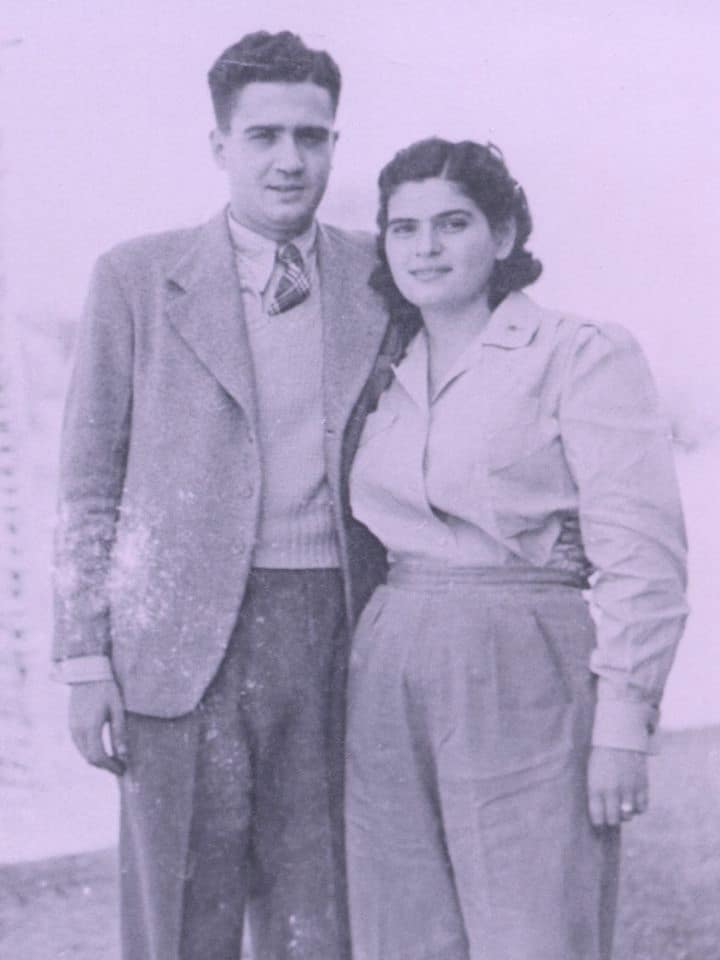 Ezra and Miriam Gubbay, Calcutta1946
Ezra and Miriam Gubbay, Calcutta1946
Normally I would have taken their answers and written out their story myself, but both Barry and Sallyanne have a wonderful way of describing these things from the heart. Instead, I decided to let them tell their family story in their own words by sharing excerpts from our email exchange. Here, Sallyanne describes her childhood in Calcutta:
In our house in Calcutta were two separate cooking areas, one for meat and one for dairy. All the kitchen help were Muslims. All the housekeeping staff and other help were Hindus. The person in charge of meal planning was a Yemenite Jew. My Grandmother and Mother would meet with him each morning to plan the day’s meals. The head chef had some knowledge of European cooking, so the menu consisted of both European types of cooking as well as Indian Jewish cooking.
If you stole someone else’s chef, it was ‘an act of war!’ The two families would never speak to each other again. Chefs were sacred.
My mom would have the chauffeur drive her to the market on many occasions to buy food. The market was indoors and there were many vendors each selling separate types of food: fruits and vegetables, baked goods, etc. Since our family was kosher, the only things my mom would bring home were fruits and vegetables. All baked goods, bread, cakes, pastries, etc. came from the Jewish bakery in town.
On Friday afternoon before Shabbat, my mom, dad and Grandmother would go to her niece’s husband’s mother’s house for tea and cakes. After that they would go to her niece’s house for dinner. They would have a splendid dinner because, according to my dad, their cook was superb! After dinner, my grandmother would either sleep over or take a rickshaw home because she would not drive on Shabbat.
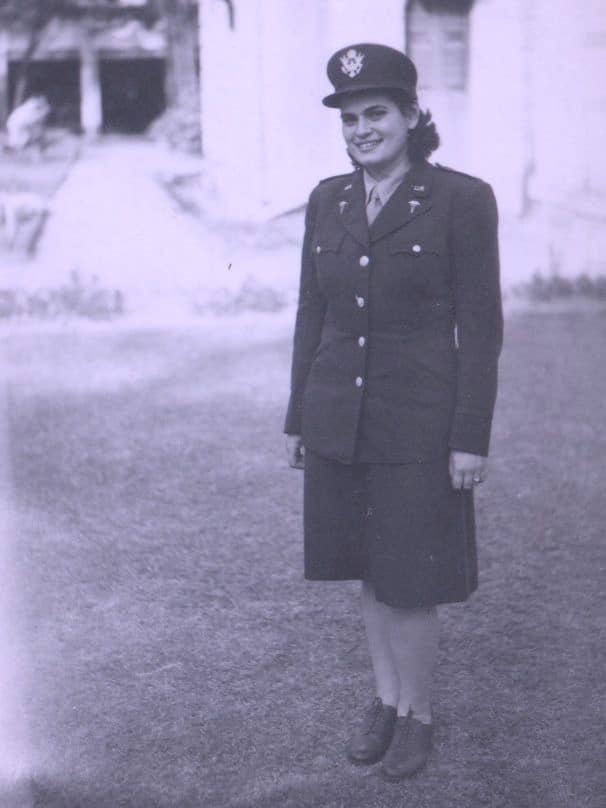 Miriam Wartell (maiden name), 2nd Lieutenant, taken between 1942-1945
Miriam Wartell (maiden name), 2nd Lieutenant, taken between 1942-1945
I wanted to learn more about Miriam, Ezra’s wife, and how the two met. Sallyanne answered my questions via email:
My mother was born and grew up in Jamaica, Queens. I believe her mother came from Poland and her dad from White Russia. She was Ashkenazi and my dad is Sephardic. My mom was a nurse at Beth Israel Hospital in NYC. She decided to join the Army. She told me they shipped her out with woolen uniforms thinking she was going to Alaska. Well she ended up in Burma on the front lines. She was a second lieutenant and a nurse anesthetist. She met my dad at a Purim party at Lady Ezra’s house. Lady Rachael Ezra always held holiday parities in Calcutta for the Jewish servicemen and women. My dad was smitten and gave her a ring on their fourth date!
My parents married in June, 1945. I was born a year later. My mom and I left India in July 1947 when they partitioned India and Pakistan. Dad came to the states 9 months later.
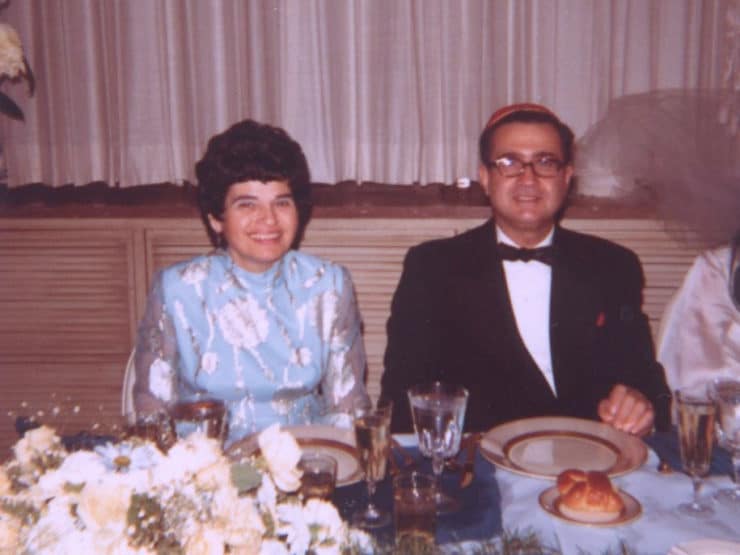
Ezra Joseph Gubbay and Miriam Gubbay, 1972
As I looked through The Jewish Cookery Book, I noticed there were handwritten notations next to many of the recipes. Barry explained:
My father-in-law annotated some of the recipes. ‘Best if made well,’ ‘good,’ ‘Yom Kippur,’ and my personal favorite, ‘To Miriam in Hospital Calcutta.’ This was recipe number 21—Stuffed Pigeon. Nothing says I love you more than a stuffed pigeon!
Many of the recipes call for mutton, as eating beef was forbidden out of respect for their Hindi hosts. My father-in-law says that mutton was only served once a year for Passoverjust the shank bone, not the meat. All of the dishes were cooked using chicken.
The handwritten annotations warmed my heart. They showed how clearly connected the cookbook was to their family culinary history. I felt honored to be reading it, like I was being allowed a glimpse at something truly personal and special.
The Jewish Cookery Book contains all sorts of interesting kosher Indian dishes. One recipe in particular caught my eye: Bhajee, a fried potato dish with onions and spices. As I was reading this, Hanukkah was coming up and fried foods were on the menu, so I thought it might be just the thing to try. Here is the recipe as it appears in the cookbook:

Click here to print the original recipe for Bhajee
The first time I cooked this Potato Bhajee, I did it according to the vintage cookbook recipe; the only change I made was slicing the potatoes instead of halving them. I couldn’t imagine larger potatoes frying evenly when halvedthick slices seemed like a much safer bet. Perhaps the dish was originally made with smaller potatoes? Unfortunately I didn’t have any on hand, so I went with thickly sliced russets.
As sometimes happens with vintage recipes, the result was slightly disappointing. While the flavor was terrific, it turned out far too oily and heavy. One cup of olive oil? I love fried foods, but holy moly this was greasy. The onion also browned much faster than the potatoes, which made it a tricky dish to cook properlya higher oil temperature will keep the potato from soaking up too much grease as it cooks, but it will also blacken the onion. Here’s a picture of the first attempt:

I really loved the flavor and the concept of the dish, so I decided to make some modifications. On my second attempt, to lighten things up, I decided to “oven fry” the potatoes firstthis requires far less oil, and crisps them up nicely. After browning them in the oven, I tossed the potatoes with the softened fried onions in a skillet till it was all nicely cooked and caramelized. The ingredients stayed the same (with a big reduction in oil), only the cooking method was different.
The result? A delicious side dish that is very similar in flavor to the original Potato Bhajee recipe, with far fewer calories. I’ve given you my lightened up version below. If you’d like, you can stick with the original recipe (printed above), which is also very goodjust too heavy for my taste. Next time I make this dish, I will likely make one more modification, to double the potatoes and halve the onions. I prefer a ratio of more potatoes to onions. That is a personal preference, though.
One more note on the cooking process… I used whole toasted coriander seeds and crushed them with a mortar and pestle, rather than using powdered coriander. My Indian Jewish friend Malka (who descends from the Bene Israel Jews) once told me to use whole spices in Indian cooking whenever possible, because they retain more flavor than powdered spices. You can certainly use powdered coriander in a pinch; toasting and grinding the seeds is the preferred method.
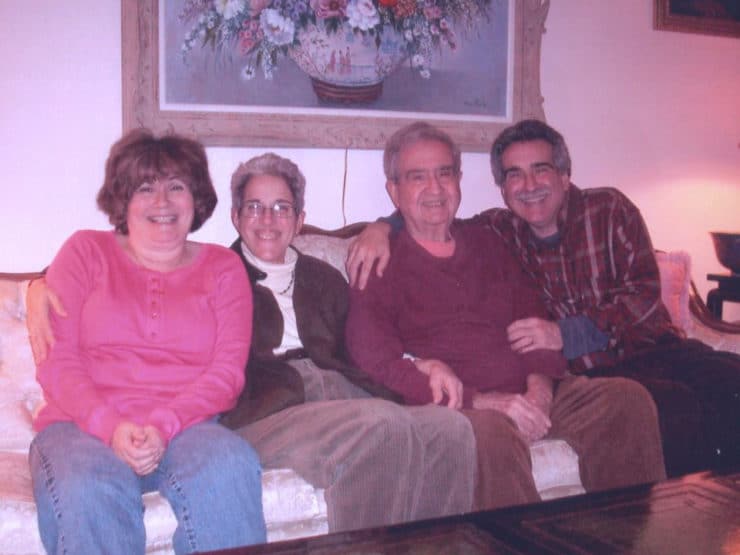
Ezra Gubbay & family. Daughters Sallyanne and Lauren, Ezra,
& son Joseph, 2010
Thank you so much to Sallyanne and Barry Scott, Ezra Joseph Gubbay, and family for providing us with this unique look at Jewish Indian cuisine! I am looking forward to trying more of the recipes in the Jewish Cookery Book over the next few months.
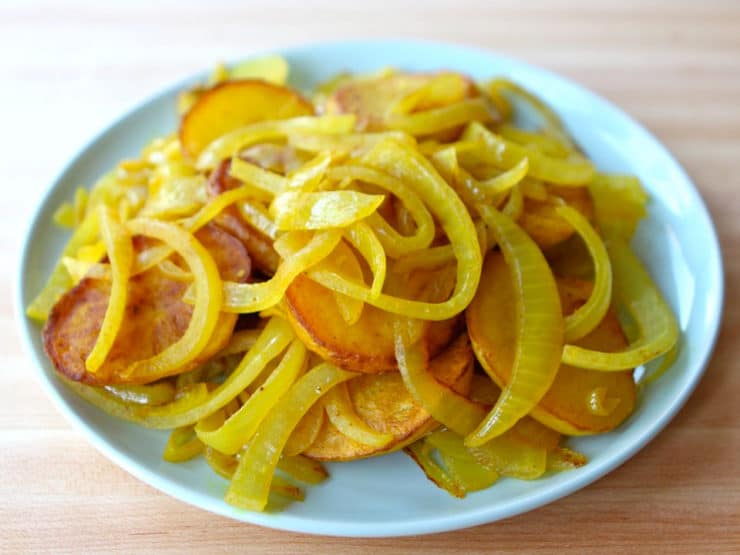
POTATO BHAJEE
Ingredients
- 3/4 tsp whole coriander or 1/2 tsp powdered coriander spice
- 1/4 cup extra virgin olive oil
- 1/2 tsp turmeric
- 1/2 tsp salt
- Black pepper to taste
- 1 lb. peeled potatoes (Russet or Yukon Gold)
- 4 small onions, peeled and sliced
- 1/2 tsp minced fresh garlic
You will also need
- a large skillet, a mortar and pestle or spice grinder (if using whole coriander seeds)
4 Servings
Kosher Key: Pareve
Preheat oven to 425 degrees F. If using whole coriander seed, pour the seeds into dry skillet. Toast them over medium heat for 3-5 minutes, stirring constantly, till fragrant. Do not let them burn. Crush the seeds to a powder using a mortar and pestle or a spice grinder. Measure out 1/2 tsp of coriander powder; reserve.
In a small bowl, whisk together olive oil, coriander powder, turmeric, salt and pepper. Slice the potatoes into rounds about 1/4 inch thick; make sure all slices are of an even thickness. Place them on a baking sheet. Spray the sheet with nonstick cooking spray, or line the sheet with nonstick foil, if you have it-- it will help keep the potatoes from sticking. Brush each potato slice with a layer of the spiced oil. Turn the slices and brush the other sides with another layer of oil. You should only use about half of the spiced oil; reserve the other half.
Place baking sheet on the middle rack of the oven. Let the potato slices roast for 15 minutes. Remove the sheet from the oven and flip the potato slices. Put the sheet back in the oven, turning it so that the opposite side faces the front of the oven, and let it continue to roast for about 10 minutes longer till the potato slices are golden brown and tender. Scoop up the oven fried potatoes with a slotted spatula and place them on a plate or in a bowl.
Place the onion slices in a large saute pan. Pour the leftover oil from the baking sheet over the top of the onions, along with the reserved spiced oil. Stir the onions to coat them with the oil. Turn heat to medium and let the onions warm up, stirring frequently, till they begin to fry. Fry the onion for about 10 minutes till the slices soften and turn yellow from the spices. Add the garlic and continue to saute till garlic is fragrant. Add potatoes to the pan and gently toss them with the onions, being careful not to break them apart. Let the mixture continue to fry for a few minutes longer until the onions caramelize at the edges.
Serve the potatoes and onions as a side dish.
Click here for the print version of this recipe.
Tori Avey
The Shiksa in the Kitchen
http://www.theshiksa.com